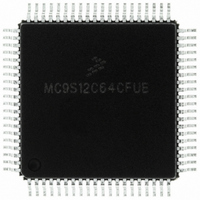MC9S12C64CFUE Freescale Semiconductor, MC9S12C64CFUE Datasheet - Page 433

MC9S12C64CFUE
Manufacturer Part Number
MC9S12C64CFUE
Description
IC MCU 64K FLASH 4K RAM 80-QFP
Manufacturer
Freescale Semiconductor
Series
HCS12r
Specifications of MC9S12C64CFUE
Core Processor
HCS12
Core Size
16-Bit
Speed
25MHz
Connectivity
CAN, EBI/EMI, SCI, SPI
Peripherals
POR, PWM, WDT
Number Of I /o
60
Program Memory Size
64KB (64K x 8)
Program Memory Type
FLASH
Ram Size
4K x 8
Voltage - Supply (vcc/vdd)
2.35 V ~ 5.5 V
Data Converters
A/D 8x10b
Oscillator Type
Internal
Operating Temperature
-40°C ~ 85°C
Package / Case
80-QFP
Processor Series
S12C
Core
HCS12
Data Bus Width
16 bit
Data Ram Size
4 KB
Interface Type
CAN/SCI/SPI
Maximum Clock Frequency
25 MHz
Number Of Programmable I/os
60
Number Of Timers
8
Maximum Operating Temperature
+ 85 C
Mounting Style
SMD/SMT
3rd Party Development Tools
EWHCS12
Development Tools By Supplier
M68EVB912C32EE
Minimum Operating Temperature
- 40 C
On-chip Adc
8-ch x 10-bit
Package
80PQFP
Family Name
HCS12
Maximum Speed
25 MHz
Operating Supply Voltage
2.5|5 V
Height
2.4 mm
Length
14 mm
Supply Voltage (max)
2.75 V, 5.5 V
Supply Voltage (min)
2.35 V, 2.97 V
Width
14 mm
Lead Free Status / RoHS Status
Lead free / RoHS Compliant
Eeprom Size
-
Lead Free Status / Rohs Status
Lead free / RoHS Compliant
Available stocks
Company
Part Number
Manufacturer
Quantity
Price
Company:
Part Number:
MC9S12C64CFUE
Manufacturer:
Freescale Semiconductor
Quantity:
10 000
- Current page: 433 of 690
- Download datasheet (4Mb)
14.5
The reset values of registers and signals are described in the Memory Map and Registers section (see
Section 14.3, “Memory Map and Register
14.6
The SPIV3 only originates interrupt requests when SPI is enabled (SPE bit in SPICR1 set). The following
is a description of how the SPIV3 makes a request and how the MCU should acknowledge that request.
The interrupt vector offset and interrupt priority are chip dependent.
The interrupt flags MODF, SPIF and SPTEF are logically ORed to generate an interrupt request.
14.6.1
MODF occurs when the master detects an error on the SS pin. The master SPI must be configured for the
MODF feature (see
changed:
The MODF interrupt is reflected in the status register MODF flag. Clearing the flag will also clear the
interrupt. This interrupt will stay active while the MODF flag is set. MODF has an automatic clearing
process which is described in
14.6.2
SPIF occurs when new data has been received and copied to the SPI Data Register. After SPIF is set, it
does not clear until it is serviced. SPIF has an automatic clearing process which is described in
Section 14.3.2.4, “SPI Status Register (SPISR).”
of the next transfer (i.e. SPIF remains active throughout another transfer), the latter transfers will be
ignored and no new data will be copied into the SPIDR.
14.6.3
SPTEF occurs when the SPI Data Register is ready to accept new data. After SPTEF is set, it does not clear
until it is serviced. SPTEF has an automatic clearing process which is described in
Status Register (SPISR).”
Freescale Semiconductor
•
•
•
If a data transmission occurs in slave mode after reset without a write to SPIDR, it will transmit
garbage, or the byte last received from the master before the reset.
Reading from the SPIDR after reset will always read a byte of zeros.
MSTR = 0, The master bit in SPICR1 resets.
Reset
Interrupts
MODF
SPIF
SPTEF
Table
14-3). After MODF is set, the current transfer is aborted and the following bit is
Section 14.3.2.4, “SPI Status Register (SPISR).”
MC9S12C-Family / MC9S12GC-Family
Definition”) which details the registers and their bit-fields.
Rev 01.24
In the event that the SPIF is not serviced before the end
Chapter 14 Serial Peripheral Interface (SPIV3) Block Description
Section 14.3.2.4, “SPI
433
Related parts for MC9S12C64CFUE
Image
Part Number
Description
Manufacturer
Datasheet
Request
R
Part Number:
Description:
Manufacturer:
Freescale Semiconductor, Inc
Datasheet:
Part Number:
Description:
Manufacturer:
Freescale Semiconductor, Inc
Datasheet:
Part Number:
Description:
Manufacturer:
Freescale Semiconductor, Inc
Datasheet:
Part Number:
Description:
Manufacturer:
Freescale Semiconductor, Inc
Datasheet:
Part Number:
Description:
Manufacturer:
Freescale Semiconductor, Inc
Datasheet:
Part Number:
Description:
Manufacturer:
Freescale Semiconductor, Inc
Datasheet:
Part Number:
Description:
Manufacturer:
Freescale Semiconductor, Inc
Datasheet:
Part Number:
Description:
Manufacturer:
Freescale Semiconductor, Inc
Datasheet:
Part Number:
Description:
Manufacturer:
Freescale Semiconductor, Inc
Datasheet:
Part Number:
Description:
Manufacturer:
Freescale Semiconductor, Inc
Datasheet:
Part Number:
Description:
Manufacturer:
Freescale Semiconductor, Inc
Datasheet:
Part Number:
Description:
Manufacturer:
Freescale Semiconductor, Inc
Datasheet:
Part Number:
Description:
Manufacturer:
Freescale Semiconductor, Inc
Datasheet:
Part Number:
Description:
Manufacturer:
Freescale Semiconductor, Inc
Datasheet:
Part Number:
Description:
Manufacturer:
Freescale Semiconductor, Inc
Datasheet:











